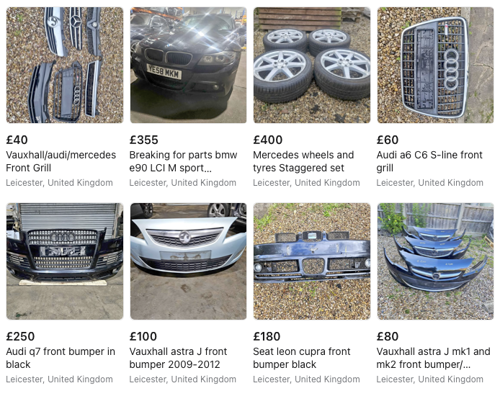Catalytic converter theft: How to prevent yours being stolen
Is your car's exhaust a tempting target for thieves? Could your catalyst be kidnapped and sold for profit? Here's all you need to know about the criminal activity targeting the underside of your vehicle.
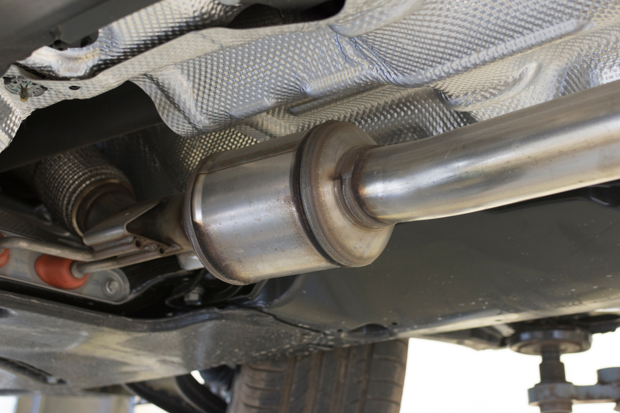
- How to prevent catalytic convertor theft
- What cars are most targeted?
- Is catalytic convertor theft covered by insurance
For more than 30 years the vast majority of vehicles sold in Britain have included an expensive component in the exhaust system — the catalytic converter. This emissions-reducing device has now become a target for brazen criminals — this guide explains why and what you can do to protect your car's cat.
What makes catalytic converters expensive? Though externally simple, the chemical reaction inside that reduces emissions of carbon monoxide (CO), carbon dioxide (CO2) and nitrous oxides (NOx) requires intense heat within carefully engineered honeycomb structures. Those are usually based on ceramic materials coated in precious metals such as platinum, palladium and rhodium.
These metals are extracted from the catalyst at the end of the vehicle's life or when it's replaced. Those rare metals alone make some a tempting target for opportunist thieves but organised crime gangs are often more interested in creating a black market for used catalysts. This in turn encourages criminals to target certain models to steal catalysts for resale rather than weigh in for scrap value.
Whether it's a car, van or pickup, someone might think there's something to steal hidden underneath even if you've already fitted a cheaper aftermarket catalyst. By the time they find it's worthless it may be too late.
Here are some practical steps you can take to make sure no criminals try to interfere with your vehicle's undersides in the first place.
How do catalytic converter thefts happen?
The majority of catalytic converter thefts are performed by criminals equipped for the job. They'll have an angle grinder, a jack and an eye for the sort of recent vehicles likely to contain the high-value component in working condition. Generally thefts will occur as a spate in a given area rather than a lone item stolen at random.
What the cat thieves don't have is much respect for property. The technique for stealing the component from under the car generally involves jacking wherever is convenient and cutting wherever is easiest to remove the section of exhaust and wiring loom that holds the precious item. It's quicker than unbolting the catalytic converter properly.
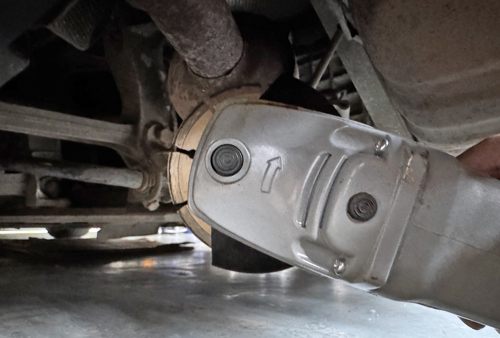
Operating an angle grinder in a rush near the car's floor, brake pipes, fuel lines, wiring and even the gearbox on some cars, as well as any support brackets, can result in significant damage and cost way beyond replacing the catalyst.
At best they will need a full exhaust system and a section of wiring loom for the electronic sensors — at worst, there may be sill, floor and bodywork repairs as well as the replacement of other critical components such as transmission oil coolers vulnerable during the theft.
The cost of a new catalytic converter can be as little as £130 for an approved pattern-part replacement but the cost of repairing cat theft damage can cost thousands or even completely write-off the car.
How can I prevent catalytic converter theft?
There's not a huge amount you can do if your car is a model that is being targeted and you need to use it and leave it parked in places the public can access — although these thefts are still relatively rare.
Parking in a different spot every day, not leaving the car unattended for days or weeks at a time and parking in bright, well-lit areas with CCTV coverage is advice that applies to any vehicle likely to be targeted by thieves.
Fit anti-catalyst theft devices
For many cars the catalytic converter is already hard to access but for some models the amount of space around it makes it an easy target. You can buy plates to fit across the underside of the car or wire mesh that tangles and frustrates any attempt to use an angle grinder in a confined space.
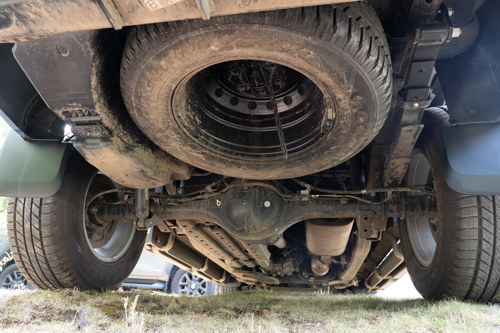
This approach is particularly effective for owners of SUVs and pickups where increased ground clearance can make catalysts much more accessible. An example of the criminal-foiling measures you can take is the Truckman Catloc.
Installing a tilt-sensitive alarm and 'break-to-alert' wiring tethers can also provide additional discouragement.
Non-original catalyst window stickers
Targeted thefts from specific models, such as hybrid Toyotas, may be discouraged by putting a sticker in the side windows that says the original catalytic converter has been replaced with a cheaper aftermarket one. Replacement models aren't worth as much to resell and often aren't of a quality worth recycling.
Be careful when advertising a car for sale
If you have an older model that is often targeted, such as Japanese hybrids or sports cars, be cautious when offering it for sale. Take pictures in a place other than where you usually leave it parked and make a note of any enquires recording phone numbers and names.
Park in a way that makes the car hard to jack up or access
If you have pavement parking with a kerb that you can legally park on without obstructing pedestrians, park on it with the centre of the car as close to the kerb as possible. This angle will make the car harder to jack up safely and very hard to do so from the roadside with sufficient height to access the exhaust components.
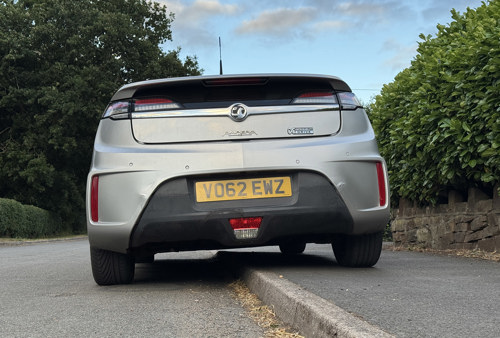
If you have a lawn, you can put some reinforced parking plates into the grass just below the tyres, without affecting the appearance. Any use of a jack will involve using the device on soft soil and grass, so it will sink under the car's weight rather than lifting it.
If you live on a road with parking spaces marked over speed bumps and your car doesn't have suspension that lowers when the car is turned off, park with the speed bump just behind the front wheels. If you do have the sort of suspension that offers height adjustment it's worth lowering it right down when parking on a flat surface.
Parking on a private drive, behind gates, or locked in a garage is naturally the safest option — particularly for cars with rear or mid-mounted engines, such as the Porsche 911 or non-electric Smart Fortwos. These cars have cats located near the rear bumper and are almost as vulnerable to theft as catalysts on high-rise pickups.
Park between cars, front-first and close to obstructions
The same theory as parking on a kerb applies, at least to vehicles with lower ground clearance. Leaving as little access as possible to the side and front of the car will make it extremely difficult to reach the catalytic converter.
Ultimately the best way of preventing catalytic converter theft is to make your vehicle too much trouble for a quick jack, cut and run operation. Anything that obstructs access or causes thieves to feel exposed and vulnerable to being recorded will make your car less appealing than an unattended vehicle parked in a dark spot and not overlooked.
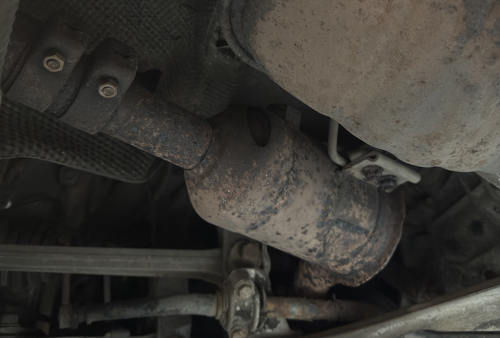
It's much the same as preventing the spates of car radio thefts that were once commonplace. That tailed off through manufacturers making the radios worthless, bespoke to specific models and tied to the car's electronics. Close-coupled catalysts in the engine bay, extra layers of shielding and VIN-stamping make new car catalysts harder to steal — and harder to sell.
How can catalyst thieves be reported and caught?
If you see any kind of theft in progress do not approach the criminals. Usually there will be more than one, and by the nature of catalyst thieves' activity they are armed with power tools and heavy ironwork that can be used as a weapon. If you can take pictures of the scene and any vehicles nearby, particularly vans or pickups, without lingering then that information may be useful to police.
Dashcam with parking mode
Installing a dashcam with parking mode — particularly models with 360-degree or car interior coverage and reliable cloud storage of footage — may capture video that helps identify perpetrators. Some models may alert you to activity near your car and allow a live feed, allowing a call to police while a theft is in progress and GPS-linked location information.
Cameras from ThinkWare are available with on-board 4G/LTE connectivity but for a car parked next to your house or on the drive many models can use your home WiFi if it's in range. A parking mode pack will provide power to the camera when the car is off and only cut off if the car's battery drops below a specified voltage.
Smartwater
Smartwater is an evolution of the 1980s trend of scribbling your postcode on your VCR with a UV pen. It's not easy to see, it's even less easy to remove and it's not obvious — but you get stickers to announce the use of it, which may discourage a thief before they get too near your car.
It's popular with farms and supply stores and essentially marks the object with a unique identifying combination of chemicals that can be read with tools used by the police and forensic services. This does mean that the registration should be updated if ownership of the vehicle is transferred or contact details change.
Smartater is useful not only for tracking a catalytic converter, it can help identify parts from valuable cars stolen and broken up to resell via a criminal 'chop-shop'. It is also available as a spray to mark a thief.
CCTV
In many ways CCTV is like a dashcam and mostly useful after the fact rather than preventing theft in the first place. If you park on your own drive or at work, place the vehicle facing an available camera rather than side on.
Systems such as a Ring doorbell, Arlo security cameras and similar are internet connected and with a subscription will retain footage captured even if the device itself is attacked.
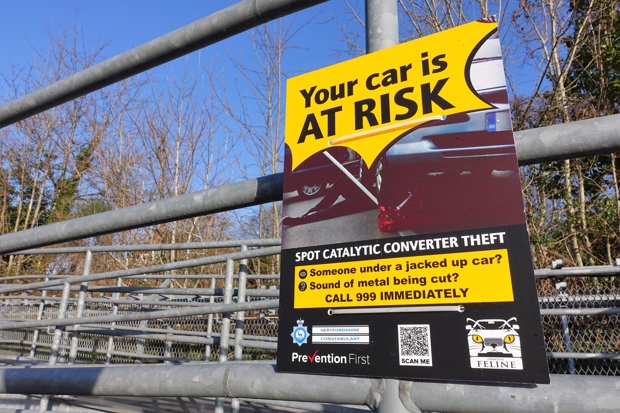
Is catalytic converter theft covered by car insurance?
Most comprehensive policies treat catalytic converter theft as vandalism and you can claim for the damage subject to your excess and vehicle value. This does run the risk of the car being written-off if it's an older model, particularly if there is damage to the sills or subframes through clumsy jacking and cutting.
Very few third party, fire & theft policies will cover for the theft of the converter alone. The theft cover applies for the whole vehicle being taken. If your car was stolen, moved elsewhere and recovered with damage including loss of the catalytic converter, then it's likely that this would be covered under damage due to theft.
This is not, typically, how catalytic converters are stolen. Historically some insurers may have treated cat theft damage as 'attempted theft' damage — but as cat thefts became more prolific they've been treated differently and as such, you probably want to make sure you have comprehensive insurance if you're concerned about cat theft.
Good news, though — for the majority of drivers and policyholders comprehensive cover is often cheaper than third party, fire and theft, because the profile of TPFT policyholders generally involves a higher claims ratio from people looking for the cheapest cover.
Which cars are targeted for catalyst theft?
- Hybrid and plug-in hybrid models are particularly at risk
- Japanese cars and light commercials get targeted often
- Premium brands may be chosen for resale rather than scrap value
By far the most popular vehicles targeted for catalytic converter theft are Toyota and Honda, where the complex and effective components are chosen for both their raw material and scrap value, as well as their potential resale value to owners who need a replacement due to engine failure or, ironically, theft.
Yes the knock-on effect of catalyst thefts is a greater demand for used catalytic converters as a replacement part, which in turn drives more thefts. This is in addition to tighter control of MOT test standards expecting to see a type-approved, original converter in place. This also applies to diesel particulate filters (DPFs) which are harder to steal but similarly sought after for older cars.
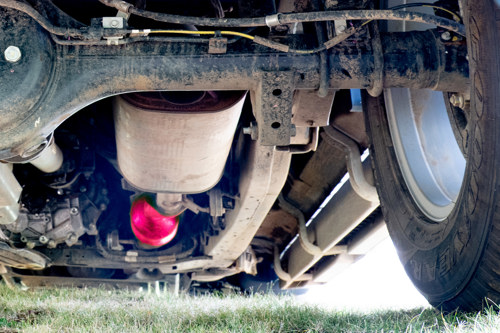
More recent diesel cars also feature catalytic converters — despite the association with unleaded petrol, diesel vehicles rely on catalysts as well to reduce pollution. Large SUVs, pickups and vans are particularly at risk because the market for a used component is global and the parts are easier to get at without jacking up the vehicle.
Is it worth buying a car after the cat's been stolen?
- Damage is rarely confined to just a missing catalytic converter
- All the poential problems of a typical used car are just as likely to be there
- If it's been passed around owners after the theft, walk away
You will often see cheap cars advertised by victims of cat theft who have found that their insurance doesn't cover the loss or where the cost of claiming is higher than the car's value. Typically older BMWs, Mercedes, Hondas and Toyotas, as well as some modern classics.
Chances are the seller has already explored the options for repair before resale and the availability of cheap type-approved aftermarket catalytic converters means that anything that looks like a bargain probably has damage far beyond simply replacing the exhaust components. If you can't get a pattern catalyst for it original components can cost thousands. The chances of getting a cheap second-hand item that isn't itself stolen are slim.
If the car has good history, has not got an insurance write-off marker and is for sale by the person that owned it at the time the catalyst was stolen then it might be worth looking at. Check the sills for damage, look for scratch marks, cuts and dents in the floor and compare the layout of remaining exhaust components with the factory workshop manual or a good example of the car.
Bear in mind that without the catalytic converter, you can't check for the many other problems a second hand car could be hiding, can't road test it and won't be able to judge how well the engine management is working or the overall sound of the engine even if it does run.
You can work out the costs and values for yourself against that particular car. It might be the perfect example of a modern classic you've wanted for years, after all. But if it's been passed around a few people after the catalyst was stolen, chances are they've all found it economically or practically not worth the trouble.
In that case we'd only buy such a car to break for spares and parts to restore another one. Check breakers' prices locally and mention the car doesn't have a catalyst — you'll probably find you're paying well over the odds for what is essentially scrap.
Are other car parts at risk of being stolen?
The focus on car component theft has been on catalytic converters because they are universal. All makes and models are at risk, from small city cars to large vans and SUVs. There is a wider problem with component theft however, and you may find certain areas or makes and models are being targeted by theives.
There have been spates of bumper and headlight thefts for various models in recent years, notably Ford Fiesta, Vauxhall Corsa and Fiat Panda. The pattern? They're usually low value, cheap to insure models popular with young drivers and families on a tight budget — but the owners are unlikely to be the criminals and are often the victims of fraud or further theft.
Look for spares for any modern car and you'll find that in place of your local scrapyard, there are big chains dominating eBay, Facebook Marketplace and direct online sales. These chains don't keep a car for years waiting for it to be stripped, they pull the parts off and recycle the rest rapidly — and they charge not only for their time and labour removing the parts, often without the same care you'd use when removing it yourself, they also price in the storage charges.
The upshot of that is cars worth £1000-£2000 can have minor damage and instead of a £50 bumper or complete door from a friendly breaker, you're looking at £200 for a bumper that's often as bad as the one you want to replace, or £150-300 for a door stripped of all components.
Repair costs for secondhand cars using secondhand parts have risen so rapidly against a backdrop of faster turnaround for breakers meaning spares are potentially sold before they're recycled. As a result it's worth a casual thief stealing parts from a car they know is unattended or not moving often, particularly if it's street parked.
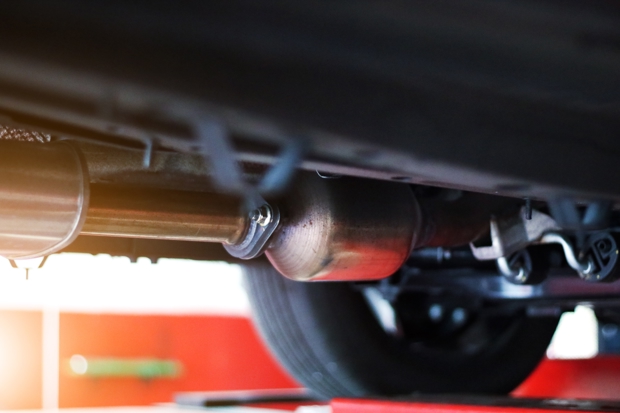
Stealing more than just parts – identity theft, or 'car cloning'
To add insult to injury, there's a good chance that your missing numberplate is now stuck on an insured or worse car racking up fines that are usually easy to defend – car cloning is so rife, police and other agencies are well aware that you're likely to be telling the truth if you were halfway to Cornwall when 'your' car was snapped speeding on the M74 and looked rather different in the photo.
There's not a lot you can do to avoid someone seeing your car's numberplate, noting the registration, and getting a set of illegally-made 'show plates' made up then using them. Amazingly it's more common to find the physical plates have been stolen from your car, leaving you to order a set of correct replacements.
It's important to inform the police immediately (but not via the emergency number) of any car part theft, including just the registration plate. Even if you simply get a crime number it will help defend against any parking or traffic notices you get.
Measures you can take against component theft
- Don't leave your car parked in the same spot for long periods away from home
- Install a dashcam with cloud storage and mobile network connectivity
- Put stickers, identifying marks or logos on the front and back of your car
As with catalytic converters, tools such as Smartwater can help forensic teams identify the origin of components, verify that they are stolen and ultimately track down the individuals and gangs behind car crime. It can be applied inside bumpers, on the back of lights, inside doors and combined with glass etching it makes a lot of anonymous parts much easier to trace.
It's better to try and dissuade criminals from targeting your car in the first place.
Don't regularly park in dark, quiet areas
One of the easiest targets for car part theft is near urban train stations in quiet housing or industrial estates, where commuters will leave their cars all day in search of free parking. Residents are unlikely to have much goodwill towards preventing thefts and the thieves know they have a working day to do as they wish before the owner returns to the car.
Use the station car park, which is usually gated and has CCTV, picking a spot near high-traffic areas. In greater London and other cities you may also find residents offering 'driveway parking' for a fee — and that could include CCTV or barriers. They may even be at home while your car is parked there.
At the very least, choose a different street, rotate and be random. Unless you have survived to 2025 without getting a smartphone, you've got a map and GPS that will record the location you parked — some apps such as Apple Maps or Waze do it automatically when you unplug the phone from the car.
Use CCTV or dashcams
We already know the always-on dashcam is a great deterrent as well as recovery/prosecution tool, particularly if it has cloud storage and access to a network either from nearby WiFi, or built-in 4G/5G modem and SIM card. Such solutions aren't cheap.
You can also get some protection though common devices such as the Ring or similar doorbell cameras. Park in view of the camera, and on some models you can set up an activity zone that would alert you to anyone tampering with numberplates or wheels.
Personalise your car
Car cloning is probably made rather easier by the sea of monochrome metallics and off-the-shelf specifications of modern cars. A personalised registration number isn't going to deter thieves — but a personalised car might. Get bumper stickers, dealer stickers, anything obvious on a picture of the front or rear of the car, and you've immediately made it easier to distinguish yours from a clone.
Some cars even have optional roof stickers and graphics which could be enough to prove that a cloned car, not yours, just got caught doing 120mph on the M40. Even if you would win a court case, wouldn't you rather be able to easily prove it wasn't your car right away?
For van owners, this is even more vital. While firms such as Amazon don't like you to have your own branding on their vans, there is nothing stopping you adding a graphic or unusual colour scheme. Stay within the law in terms of lighting and windows, though.
Fit anti-theft bolts or frames to your numberplate
This is potentially a double win as anti-tamper bolts and factory mounting points, rather than the typical 'nine pieces of 3M body tape and hope it's centred' can immediately make the casual plate thief move onto a new target.
On some cars, particularly Mercedes, you can go one step further and fit a plate frame to threaded mounting points that are integrated into the bodywork, not just self-tapping screws through plastic. Often sold as a means for quick-changing plates without drilling, if you drill the plate in line with the mounting holes and fit screws through the plate and frame into the bodywork, this makes it harder to pull the frame away from the plate.
The extra benefit of doing this is that if the plate is mounted to a bumper or tailgate securely, it adds to the amount of work needed to remove that part and sell it on. Make your car more effort than it's worth for a parts thief.
Is it safe to buy used car parts online?
- Many scrapyards now sell parts online — safe, protected but expensive
- Private sellers may want to sell parts from a car they own
- Dodgy dealers often have lots of parts, but no cars
Look for car spares, from a replacement catalytic converter or DPF to little bits of trim or ECUs and you'll find them listed on every online platform imaginable — from eBay and Facebook Marketplace, to Gumtree and even Etsy.
Scrapyards are easy to spot as they tend to use either their own websites or partner sites that offer 'parts finding' services. They will grade items, usually give several pictures and frequently offer some warranty that the part will be useful. Not always but it will be clear if that isn't the case.
Classified sellers are harder. Is it a car enthusiast, an owner who has been offered pennies for their broken car and wants to sell bits to get more than scrap, or a dodgy dealer? Some simple rules might help you avoid accidentally buying stolen parts — though the best route when buying secondhand parts is to be able to go and see the car the parts were removed from.
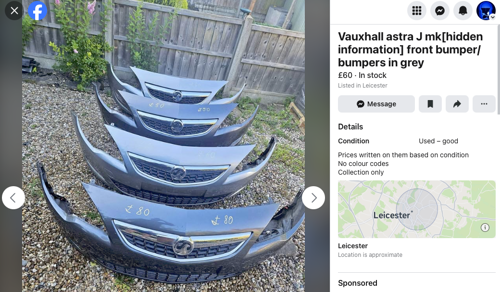
Are they selling lots of parts from the same make or model of car?
Even if the seller doesn't have the car the parts are from anymore, if they've got a lot of parts and they know the numbers, years and condition of the components they are more likely to be an enthusiast who breaks cars they know well, or is clearing out parts they have saved up.
Are they inviting you to remove the parts yourself or offering you a whole car?
You've probably found someone who wants to get as much money as they can back for their broken or damaged car. They may even have had it written off due to cat theft. Even if they don't know much about cars, they should be able to tell you a bit about the parts they're selling such as age and working condition.
Do they have a lot of listings for bumpers, wheels and bits from different makes and models?
Take a look at the background of the pictures when looking at their other listings. Is it a lawn, a patio or an industrial unit? Are there complete cars visible or just piles of bits?
If they've got a set of different bumpers and wheels, all on the same bit of lawn with minimal descriptions there is a good chance that they're a business pretending to be a private seller, or someone selling stolen parts. Be wary.
